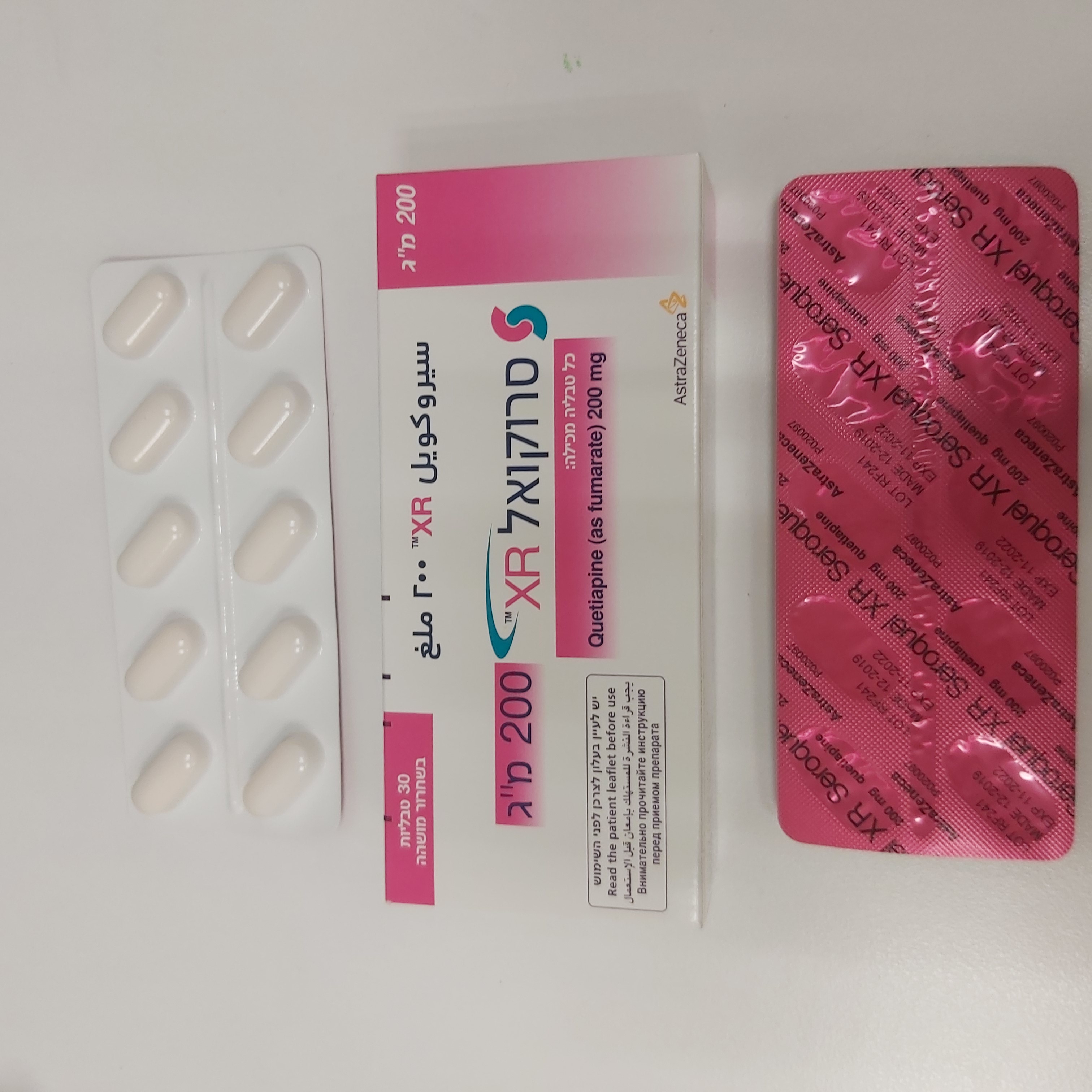Quest for the right Drug

סרוקואל 200 מ"ג XR SEROQUEL XR 200 MG (QUETIAPINE FUMARATE)
תרופה במרשם
תרופה בסל
נרקוטיקה
ציטוטוקסיקה
צורת מתן:
פומי : PER OS
צורת מינון:
טבליות עם שחרור נרחב : TABLETS EXTENDED RELEASE
עלון לרופא
מינוניםPosology התוויות
Indications תופעות לוואי
Adverse reactions התוויות נגד
Contraindications אינטראקציות
Interactions מינון יתר
Overdose הריון/הנקה
Pregnancy & Lactation אוכלוסיות מיוחדות
Special populations תכונות פרמקולוגיות
Pharmacological properties מידע רוקחי
Pharmaceutical particulars אזהרת שימוש
Special Warning עלון לרופא
Physicians Leaflet
Interactions : אינטראקציות
4.5 Interaction with other medicinal products and other forms of interaction Given the primary central nervous system effects of quetiapine, quetiapine should be used with caution in combination with other centrally acting medicinal products and alcohol. Caution should be exercised treating patients receiving other medications having anti-cholinergic (muscarinic) effects (see Section 4.4). Cytochrome P450 (CYP) 3A4 is the enzyme that is primarily responsible for the cytochrome P450 mediated metabolism of quetiapine. In an interaction study in healthy volunteers, concomitant administration of quetiapine (dosage of 25 mg) with ketoconazole, a CYP3A4 inhibitor, caused a 5- to 8-fold increase in the AUC of quetiapine. On the basis of this, concomitant use of quetiapine with CYP3A4 inhibitors is contraindicated. It is also not recommended to consume grapefruit juice while on quetiapine therapy. In a multiple dose trial in patients to assess the pharmacokinetics of quetiapine given before and during treatment with carbamazepine (a known hepatic enzyme inducer), co-administration of carbamazepine significantly increased the clearance of quetiapine. This increase in clearance reduced systemic quetiapine exposure (as measured by AUC) to an average of 13% of the exposure during administration of quetiapine alone; although a greater effect was seen in some patients. As a consequence of this interaction, lower plasma concentrations can occur, which could affect the efficacy of quetiapine therapy. Co-administration of quetiapine and phenytoin (another microsomal enzyme inducer) caused a greatly increased clearance of quetiapine by approx. 450%. In patients receiving a hepatic enzyme inducer, initiation of quetiapine treatment should only occur if the physician considers that the benefits of quetiapine outweigh the risks of removing the hepatic enzyme inducer. It is important that any change in the inducer is gradual, and if required, replaced with a non-inducer (e.g. sodium valproate) (see section 4.4). The pharmacokinetics of quetiapine were not significantly altered by co-administration of the antidepressants imipramine (a known CYP 2D6 inhibitor) or fluoxetine (a known CYP 3A4 and CYP 2D6 inhibitor). The pharmacokinetics of quetiapine were not significantly altered by co-administration of the antipsychotics risperidone or haloperidol. Concomitant use of quetiapine and thioridazine caused an increased clearance of quetiapine with approx. 70%. The pharmacokinetics of quetiapine were not altered following co-administration with cimetidine. The pharmacokinetics of lithium were not altered when co-administered with quetiapine. In a 6-week, randomised, study of lithium and SEROQUEL XR versus placebo and SEROQUEL XR in adult patients with acute mania, a higher incidence of extrapyramidal related events (in particular tremor), somnolence, and weight gain were observed in the lithium add-on group compared to the placebo add-on group (see section 5.1). The pharmacokinetics of sodium valproate and quetiapine were not altered to a clinically relevant extent when co-administered. A retrospective study of children and adolescents who received valproate, quetiapine, or both, found a higher incidence of leucopenia and neutropenia in the combination group versus the monotherapy groups. Formal interaction studies with commonly used cardiovascular medicinal products have not been performed. Caution should be exercised when quetiapine is used concomitantly with medicinal products known to cause electrolyte imbalance or to increase QT interval. There have been reports of false positive results in enzyme immunoassays for methadone and tricyclic antidepressants in patients who have taken quetiapine. Confirmation of questionable immunoassay screening results by an appropriate chromatographic technique is recommended.

פרטי מסגרת הכללה בסל
א. הטיפול בתרופה יינתן : 1. למבוטח בגיר שהוא חולה סכיזופרניה;2. למבוטח קטין הסובל מסכיזופרניה או מפסיכוזה אחרת; 3. בהפרעה ביפולרית כקו טיפולי שני. ב. התחלת הטיפול בתרופה תהיה על פי הוראתו של רופא מומחה בפסיכיאטריה או בפסיכיאטריה של הילד והמתבגר, לפי העניין. ג. לא יינתנו לחולה בו בזמן שתי תרופות או יותר ממשפחת התרופות האנטיפסיכוטיות האטיפיות.
מסגרת הכללה בסל
התוויות הכלולות במסגרת הסל
| התוויה | תאריך הכללה | תחום קליני | Class Effect | מצב מחלה |
|---|---|---|---|---|
| בהפרעה ביפולרית כקו טיפולי שני. | ARIPIPRAZOLE, OLANZAPINE, QUETIAPINE | |||
| למבוטח קטין הסובל מסכיזופרניה או מפסיכוזה אחרת; | ||||
| למבוטח בגיר שהוא חולה סכיזופרניה; | OLANZAPINE, ARIPIPRAZOLE, AMISULPRIDE, ILOPERIDONE, QUETIAPINE, PALIPERIDONE, SERTINDOLE, ZIPRASIDONE |
שימוש לפי פנקס קופ''ח כללית 1994
לא צוין
תאריך הכללה מקורי בסל
15/05/2006
הגבלות
תרופה מוגבלת לרישום ע'י רופא מומחה או הגבלה אחרת
מידע נוסף
עלון מידע לרופא
08.06.22 - עלון לרופאעלון מידע לצרכן
07.04.21 - עלון לצרכן אנגלית 08.05.22 - עלון לצרכן אנגלית 08.06.22 - עלון לצרכן עברית 08.05.22 - עלון לצרכן ערבית 19.09.22 - עלון לצרכן אנגלית 19.09.22 - עלון לצרכן ערבית 25.04.17 - החמרה לעלון 06.08.19 - החמרה לעלון 07.04.21 - החמרה לעלון 02.09.21 - החמרה לעלון 19.12.21 - החמרה לעלון 08.05.22 - החמרה לעלון 08.06.22 - החמרה לעלוןלתרופה במאגר משרד הבריאות
סרוקואל 200 מ"ג XR